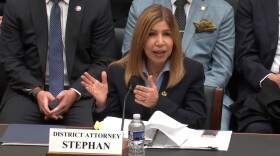An older-style voice recorder inside the cockpit of a Northwest Airlines plane had only a 30-minute recording capacity, making it more difficult to determine why the pilots went 150 miles beyond their Minneapolis destination before turning around, air safety investigators said Friday.
Flight 188 was out of touch with air traffic controllers for more than an hour Wednesday night, leaving ground personnel concerned the plane was in distress or had been hijacked. Authorities were on the verge of scrambling four military fighter jets to overtake the airplane when it re-established contact about 8:14 p.m. CDT.
Investigators said controllers in Minneapolis and Denver tried repeatedly to get the attention of the crew, even recruiting the pilots of nearby planes to try to reach the plane on another frequency.
FBI agents and airport police boarded the plane after it landed safely in Minneapolis, taking the voice cockpit and flight data recorders and talking to the crew while the 144 passengers waited to deplane.
The pilots explained the incident by saying they were having a heated discussion over airline policy and lost track of where they were. But investigators with the National Transportation Safety Board are trying to determine whether the pilots could have fallen asleep.
John Golgia, a former National Transportation Safety Board member, said fatigue levels of flight crews were a growing concern.
"I think it's now time for all of us in aviation to stand up and address these issues of fatigue, how we're going to combat the issues of fatigue, and what kind of technology we can use to enhance the alertness of flight crews," he said.
En route from San Diego to Minneapolis, the plane was in contact with air traffic controllers in Denver as it flew over the Rocky Mountains, but they lost touch as the plane neared Minneapolis.
Denver controllers notified their counterparts in Minneapolis, who also tried to reach the crew without success, Brown said.
Officials suspected Flight 188's radio might still have been tuned to a frequency used by Denver controllers even though the plane had flown beyond their reach, said Doug Church, a spokesman for the National Air Traffic Controllers Union.
Minneapolis controllers don't have the capability of using the Denver frequency, but pilots do. So controllers asked the pilots of other planes to try to raise Flight 188 using the Denver frequency.
Initially, those attempts were unsuccessful, but two pilots finally got through just before the plane turned around, Church said.
After re-establishing contact with the Northwest pilots, controllers were so concerned that the plane might have been hijacked that they asked the pilot to execute a series of turns to show he was in control of the aircraft, Church said.
"Controllers have a heightened sense of vigilance when we're not able to talk to an aircraft. That's the reality post-9/11," he said.
NTSB investigators plan to schedule interviews with the crew. The FBI and airport police interviewed the crew at the time of the incident.
Northwest Airlines officials said they have suspended the pilots until the investigation is complete.
Ben Berman, an airline pilot and former chief of major accident investigations at the NTSB, doubted the pilots' excuse. He said the pilots would ordinarily have begun preparing for landing when the flight was still 100 miles or more away from Minneapolis.
Shop talk "pretty clearly wasn't all that was going on," Berman said.
The jet was over Eau Claire, Wis., when crew members discovered they had overflown their destination and contacted controllers in Minneapolis.
Passengers said they had no idea that anything was wrong.
Andrea Allmon, who had been traveling from San Diego on business, didn't know anything was amiss.
"Everybody got up to get their luggage, and the plane was swarmed by police as we were getting our bags down from the overhead bins," she said.
She said they were kept on the plane briefly while police talked to the crew. Allmon said she was horrified to learn what had happened.
The FAA is updating rules governing how many hours commercial pilots may fly and remain on duty. The NTSB also cautioned government agencies this week about the risks of sleep apnea contributing to transportation accidents.
In January 2008, two go! Airlines pilots fell asleep for at least 18 minutes during a midmorning flight from Honolulu to Hilo, Hawaii. The plane passed its destination and was heading out over open ocean before controllers raised the pilots. The captain was later diagnosed with sleep apnea.
Air traffic controllers in Denver had been in contact with the Northwest pilots as they flew over the Rockies, but contact was lost as they neared Minneapolis just before 8 p.m., said FAA spokeswoman Laura Brown.
Denver controllers notified their counterparts in Minneapolis, who also tried to reach the crew without success, Brown said.
With reporting by Tim Nelson of Minnesota Public Radio and wire services
Copyright 2022 NPR. To see more, visit https://www.npr.org. 9(MDAzMjM2NDYzMDEyMzc1Njk5NjAxNzY3OQ001))






